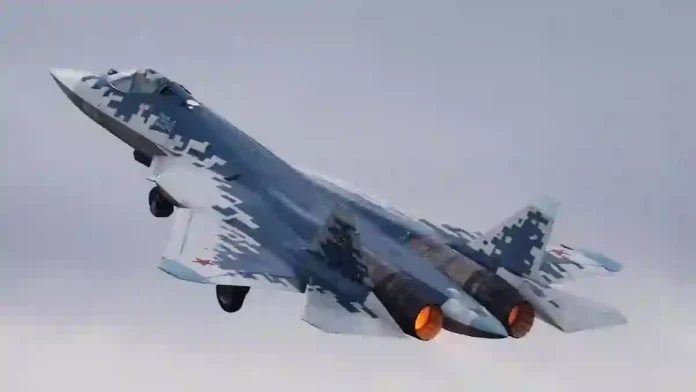India is actively evaluating Russia’s Su-57 fifth-generation stealth fighter as a potential solution to the Indian Air Force’s (IAF) shrinking combat strength. The proposal is expected to feature prominently on the agenda during President Vladimir Putin’s visit to New Delhi for the 23rd India-Russia Summit in December.
Moscow has reportedly offered India a comprehensive package, including full technology transfer and joint production through Hindustan Aeronautics Limited (HAL). The arrangement seeks to replicate the Su-30MKI model, which India has been producing under license for decades, making use of existing manufacturing infrastructure and maintenance expertise.
Read- India’s STAR Missile: Indigenous Supersonic Target System Redefining Combat Readiness
The Su-57, also known as the Su-57E in export configuration, offers stealth, supercruise, and advanced avionics capabilities. While Western critics have flagged concerns about its stealth profile and limited production numbers, the aircraft has already seen frontline service in Ukraine, giving it operational credibility that Indian defence planners are closely studying.
Russia’s diplomatic representatives in New Delhi have underscored Moscow’s long-standing commitment to India’s defence ecosystem. Roman Babushkin, Russia’s Chargé d’Affaires, emphasized that Russia had partnered with India in defence manufacturing long before the “Make in India” initiative and assured continued support for local fighter and jet engine production.
The urgency of India’s decision stems from the IAF’s acute squadron shortfall. Current strength has fallen below 32 squadrons against a sanctioned requirement of 42, precisely as China and Pakistan increase the sophistication of their joint air operations. Procuring a fifth-generation fighter is now viewed not only as a capability upgrade but also as a deterrence necessity.
India’s interest in the Su-57 also reflects logistical familiarity. With decades of pilot and ground crew experience on Russian platforms, the induction process would be smoother and potentially faster than transitioning to a U.S.-origin platform like the F-35, which also comes with higher costs and strict end-user restrictions.
Analysts have been quick to recall the failed Fifth-Generation Fighter Aircraft (FGFA) program, a joint Indo-Russian project based on the Su-57 that collapsed in 2018. Disputes over costs, transparency, and the extent of technology sharing derailed the effort, leaving Indian officials wary of repeating past mistakes.
Proponents argue that the current Russian offer is substantially different from the FGFA framework. Unlike the earlier deal, this proposal emphasizes transfer of technology, local assembly, and giving India greater operational independence in sustaining the aircraft fleet.
Geopolitical considerations are also influencing deliberations. Washington continues to promote the F-35 as an option for India, but U.S. offers fall short of guaranteeing full production rights. Indian military planners remain cautious about sovereign control over maintenance, software, and combat employment of U.S.-made systems, leading to scepticism about the F-35’s suitability under Indian strategic conditions.
The December summit between Prime Minister Narendra Modi and President Vladimir Putin is shaping up to be decisive. Defence cooperation, particularly in next-generation fighter production and technology transfer, is expected to take center stage alongside energy and trade talks. The outcome could redefine not only India’s airpower trajectory but signal a new phase in India-Russia strategic alignment.
IDN (With Inputs From Agencies)
Agencies




